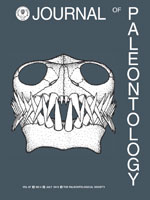The feather-shaped Plumalina Hall, 1858 is revised on the basis of new and reexamined specimens from New York. Previously described from Givetian through Famennian deposits, a single compression of P. tenera n. sp. from the Rochester Shale extends the range into the Wenlock, and provides new information regarding Plumalina's biology. We assess the utility of morphologic characters in diagnoses of taxa, and present the first quantitative analysis of fossil hydroids to distinguish P. brevis n. sp. (Frasnian) from other Devonian species.
Plumalina has been compared to plants, graptolites, and octocorals. Some interpretations have proposed affinities among hydrozoans based on colony form and the presence of putative polyp bases. Our analysis shows that, like extant thecate hydrozoans, Plumalina had a delicate, chitinous hydrocaulus with weakly articulated hydrocladia. An assemblage of in situ specimens, steeply inclined relative to the bedding plane in an Ithaca Formation (Frasnian Stage) turbidite, indicates that Devonian species produced sessile, erect colonies attached to a hard substrate, comparable to extant hydroids that feed in currents. Morphometric comparisons between putative Plumalina polyp bases and polyp bases of modern analogues reveal similarities to hydroids in the superfamily Plumularioidea McCrady, 1859. Plumalina is the most abundant fossil hydroid so far reported, and is pertinent to interpretations of the hydrozoan record.





